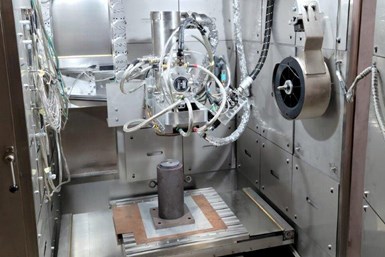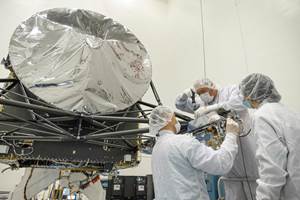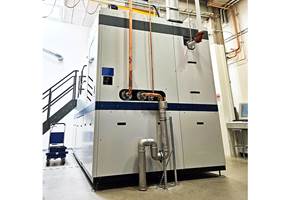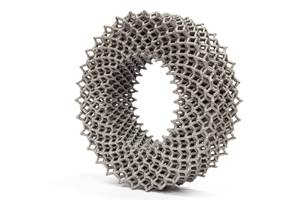Sciaky Develops Smaller EBAM-53 Machine for Labs, Research Facilities
With a much smaller space requirement and lower cost, the EBAM-53 features a build envelope of 26 in2, enabling test coupons, small demonstrators and geometry trial parts.
Sciaky Inc., a subsidiary of Phillips Service Industries and a provider of electron beam (EB) welding systems and metal 3D printing solutions, has created the EBAM-53 machine for laboratory and research facilities. This machine is well suited for users who perform research on a smaller scale with the future intent of moving into a larger, traditional Sciaky EBAM system. The first EBAM-53 will ship to a customer site before the end of 2023, and will be offered to the industry starting January 2024.
The EBAM-53 platform is suitable for materials research laboratory settings. The system has a smaller space requirement and a lower cost, but features all of the same EB additive manufacturing (AM) equipment as the larger scale EBAM systems for process optimization and materials development. The system uses the same EB generator, as well as the same sensors, computers and process control software, making users’ research directly scalable into the larger production-ready EBAM models.
The EBAM-53 can fit into laboratory and R&D settings with ease. This system will ship in standard sea containers, and will ship and install in one piece. It features a build envelope of a 26 in2 (635 mm3), enabling test coupons, small demonstrators and geometry trial parts. Like all previously delivered EBAM systems, this system features the IRISS process control software. Rotary and tilt positioners are also available as options.
“This has been a goal of Sciaky for years. We have been asked numerous times to offer a system appropriate for a research environment,” says Scott Phillips, Sciaky president. “We can now answer this part of the industry’s demand. With the EBAM-53, users can conduct meaningful research and development that can easily migrate to larger production-scale systems in the future.”
EBAM technology’s features provide manufacturers with a range of benefits, including reduced material waste, shorter lead times and increased design flexibility. By utilizing wire feedstock instead of powder, EBAM minimizes waste and cost, leading to cost savings and sustainability advantages. Moreover, the ability to fabricate near-net shape parts reduces the need for costly postprocessing and machining, thereby optimizing production time and costs.
- Learn about Sciaky delivering the world’s largest Metal EB DED 3D printer. The contract called for a customized, high-deposition EBAM 300 Series additive manufacturing system delivered to Turkish Aerospace Industries to 3D print titanium aerostructures 6 meters (nearly 20 feet) in length.
- Read about how Sciaky’s EBAM advances metal 3D printing. Sciaky Inc.’s Electron Beam Additive Manufacturing (EBAM) technology is an industrial metal 3D printing solution with approved applications on land, sea, air and space.
Related Content
Zenith Tecnica Manufactures 3D Printed Hardware for NASA Psyche Mission
The node components designed by Maxar Space Systems were well suited to the advantages of EBM AM due to their complex geometries.
Read MoreVideo: What Is Electron Beam Melting (EBM)?
Electron beam melting is the higher-energy metal 3D printing process offering advantages when it comes to productivity and thermal stresses. Here is an introduction to EBM.
Read MoreVBN Components Offers High-Performance Materials Development as a Service
Formnext 2023: VBN Components is exploring new possibilities in metal materials development, including promising prospects with hard metals and refractories.
Read MoreWayland Additive’s Calibur3 Features NeuBeam PBF Process
Formnext 2023: The company’s fully neutralized NeuBeam process for the Calibur3 metal additive manufacturing system solves the charging issues that have previously restricted electron beam melting processes.
Read MoreRead Next
Video: Intelligent Layering Metal 3D Printing at 3DEO
Contract manufacturer 3DEO delivers metal parts using Intelligent Layering, a binder jetting-like 3D printing process the company developed and operates internally. Here’s how it works.
Read MoreTo Improve Performance of Compression Molded Composites, Add 3D Printed Preforms
9T Labs' Additive Fusion Technology enables the manufacture of composite structures with as much or as little reinforcement as is necessary, using 3D printed continuous fiber preforms to add strength just where needed.
Read MoreLooking to Secure the Supply Chain for Castings? Don't Overlook 3D Printed Sand Cores and Molds
Concerns about casting lead times and costs have many OEMs looking to 3D print parts directly in metal. But don’t overlook the advantages of 3D printed sand cores and molds applied for conventional metal casting, says Humtown leader.
Read More













.png;maxWidth=300;quality=90)











